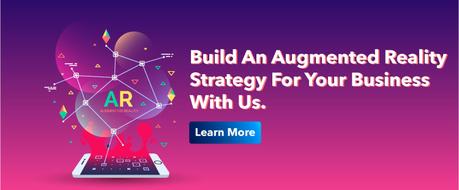According to MarketsandMarkets, the valuation for AR technology is worth $15.3 billion. The number strongly translates its worth in exploring the different avenues and trends. Last year, AR active devices were estimated to rise to 598 million units. By the end of 2024, it is projected to grow to 1.73 billion.
AR is not only allowing businesses to embrace new possibilities but also helping them to pitch potential customers globally.
Why Are Brands Adopting The Use Of AR Technology?
1. The primary objective of AR is to employ computerized simulation and rich audio-visual techniques. It offers a reality-based display environment that takes the capabilities of computer-generated display, sound, text, and effects.
2. AR technology allows effective and efficient utilization of images and speech recognition, animation, head-mounted display, and handheld devices to enhance the user's real-world experience.
3. Mobile AR, also referred to as Web AR (Web-based AR), is the use of Augmented Reality technology without the need for an app. Web AR experiences launch from within any standard iOS or Android mobile web browser and can be activated using the standard device camera.
Bonus Points:
1. It results in a highly intuitive experience that gets consumers to engage with brands in less than three taps on their phones.
Let us take a look at some Augmented Reality examples, where brands have slayed the technology game.
Sephora & TimberLand Aced The AR Game With Try-on Feature!
The inception of the COVID-19 pandemic has changed the way people shop.
Stay-at-home orders spiked up the trend of online shopping, with more than half of the population shopping online. While the pandemic also showered some negative impacts and challenged many retailers, the trend towards personalized, immersive customer experiences spurred examples of beauty and fashion brands such as L'Oreal and Pandora turning to augmented reality (AR) as a novel way to help their customers try on cosmetics, jewelry or apparel.
Some businesses aim at driving footfall to their physical stores, but Sephora has delivered a notable example of doing something very unique. Their app's AR functionality helps users to make informed choices online, ensuring that this is as helpful as visiting the physical store.
Well, imagine you need lipstick and don't know what shade to pick. Thanks to its facial recognition tech, Sephora allows a person to try out different shades on their face in real-time, compare and share looks, as well as complete the purchase.
Another striking example is the magic mirror by Timberland, to entice customers.
The brand placed a magic mirror outside its store, allowing people to try on clothing digitally. This proved to be an excellent idea for increasing footfall when launching new ranges or driving seasonal sales.
- In a year's span, the concept of using AR technology to merge an e-commerce customer experience with what they might feel in a physical store has gone mainstream.
A study by thinkmobiles.com suggests that 71% of shoppers would shop more often if they could use AR, and 40% would consider paying more if they could examine a product through AR
- It brings practical benefits for businesses to connect with the users in a better way.
- It certainly has the potential to completely change the future of brick-and-mortar stores.
HUTCH & IKEA Brings Astounding Benefits To The Table
IKEA allows its customers to feel the quality of different products. This helps buyers and interior decorators to see how an item fits into a room and generally helps build a classic prototype of the possible future of the space.
HUTCH focuses on the simple idea "to discover the inner interior designer". Their augmented reality furniture app aims to customize the living space virtually, without the risk of making unnecessary purchases. The app comprises decor elements from the most popular companies.
ALSO READ: WHAT IS AUGMENTED REALITY? WHY BUSINESSES NEED AN AR STRATEGY?
Klubs Tried Something Completely Out Of The Box!
The men's lifestyle magazine, Klubs did an impeccable job with the implementation of Augmented Reality. It featured a section dedicated to female cover models - classy and professionally done photos of women wearing little to nothing. They decided to enable the magazine's pages with augmented reality, thinking that we could really get readers to clock up AR use behind-the-scenes from photoshoots. This campaign generated a huge amount of interest and did good, overall.
Young adults, teens, and children are now born with tech inextricably intertwined with their lives. Until recently, traditional print dominated media consumption, but the popularity of the written press among Europeans has decreased. The rates of daily printed press consumption dropped from 37% in 2012 to 29 % in 2016 - and we're in 2021 now! Digital media has been steadily seeping in too.
In a situation like such, what would draw people to digital content is visual storytelling and interactivity. Especially for the younger generations, digital information is more comfortable to access and consume and often proves to be more engaging. And well, Klubs understood the assignment!
Stambol Pioneered Real Estate Marketing Through AR
AR has influenced every aspect of our lives and real estate is no exception.
Goldman Sachs predicts the virtual reality and augmented reality market in real estate could top $2.6 billion by 2025, forever altering how we view properties.
Research shows that 80% of millennials have the desire to buy their own homes and well, AR is the perfect way to garner interest.
AR in real estate superimposes images or text over our view of the world. It blurs the line between reality and technology thereby creating a seamless experience for the viewer.
In this digitally driven age, Stambol is doing a great job in showing us how:
- AR can change the real estate landscape
- To visualize a property
- To reach larger audiences and find out which aspects of AR appeal to buyers
- Businesses can increase foreign investments
The benefits of AR in the real estate industry are beyond astounding
- It provides clarity in product representation. When a customer can't visualize the end product, it can take longer to close the deal and can prevent realtors from pre-selling new projects. AR makes the product more tangible which is essential for pre-selling built and unbuilt properties.
- It lets the customer adjust the property's style, furniture, and surroundings to cater to their taste. With all this available information, realtors have a higher chance of closing a deal.
Hyundai Turned Heads When It Introduced Virtual Guide
The automotive market is expected to grow at an annual rate of 177% for the next 2 years, reaching $5.5 billion by the end of 2023.
Hyundai came with the most up-to-date and exciting features to make the user learn more about their vehicle. The user is provided with an option that scans any devices of the car. Without visiting the automobile store, users can view the car and its specific models.
The Hyundai Virtual Guide helps to go through the user manual rather than going through a dense instruction manual. The virtual content about the car manual proved to be the best way to educate the users apart from driving the car.
- Enhancement of AR services for driver experience provides them with information about the surrounding environment, conditions, and in-windshield navigation.
- AR instructions and guides replace long and complex manuals.
- AR headsets automate the training process in the manufacturing or maintenance of automobiles.
- AR guided picking helps warehouse employees become more efficient.
AR In Social Media? Watch Snapchat, Facebook & Instagram
Recently Facebook, Instagram, Pinterest, and TikTok have also launched their own lenses, filters, and effects. AR is showing its value not only for branding and entertainment but also for commerce.
While Snapchat introduced several updates, including machine-learning models and Local Lenses, Facebook is rolling out AR advertising, and Instagram is adding try-on features. Although TikTok and Pinterest are very early in their AR development, they should not be ruled out as eventual competitors.
Final Thought:


